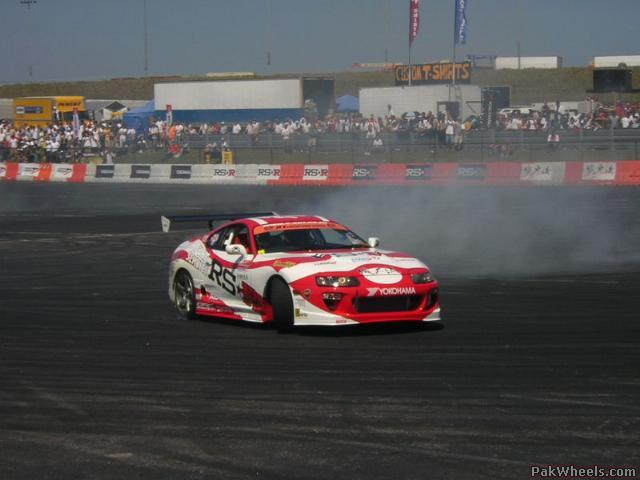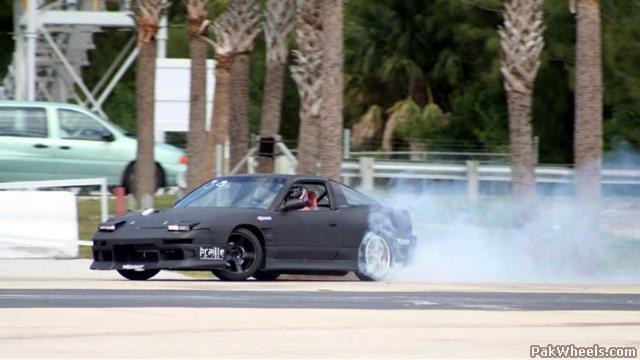source: wikipedia
Drifting refers to a driving technique and to a motor sport involving the use of the technique. This article deals primarily with the sport. A car is said to be drifting when the rear slip angle is greater than the front slip angle, and the front wheels are pointing in the opposite direction to the turn (e.g. car is turning left, wheels are pointed right), and the driver is controlling these factors.
Drift competition
Drifting competitions are judged based on line, angle, speed, and show factor. Line involves taking the correct line, which is usually announced beforehand by judges. The show factor is based on multiple things, such as the amount of smoke, how close the car is to the wall, and the crowd's reaction. Angle is the angle of a car in a drift, Speed is the speed entering a turn, the speed through a turn, and the speed exiting the turn; faster is better.
Team Drift Competition in Melbourne, Australia.
Team Drift Competition in Melbourne, Australia.
The judging takes place on just a small part of the circuit, a few linking corners that provide good viewing, and opportunities for drifting. The rest of the circuit is irrelevant, except as it pertains to setting up the car for the first judged corner. In the tandem passes, the lead driver often feints his or her entry to the first corner to upset the chase driver.
There are typically two sessions, a qualifying/practice session, and a final session. In the qualifying sessions, referred as Tansou (speed run), drifters get individual passes in front of judges (who may or may not be the final judges) to try and make the final 16. This is often on the day preceding the final.
The finals are tandem passes, referred as Tsuiso (chase attack). Drivers are paired off, and each heat comprises two passes, with each driver taking a turn to lead. The best of the 8 heats go to the next 4, to the next 2, to the final. The passes are judged as explained above, however there are some provisos such as:
- Overtaking the lead car under drift conditions almost always wins that pass.
- Overtaking the lead car under grip conditions automatically forfeits that pass.
- Spinning forfeits that pass, unless the other driver also spins.
- Increasing the lead under drift conditions helps to win that pass.
- Maintaining a close gap while chasing under drift conditions helps to win that pass.
Points are awarded for each pass, and usually one driver prevails. Sometimes the judges cannot agree, or cannot decide, or a crowd vocally disagrees with the judge's decision. In such cases more passes may be run until a winner is produced. Sometimes mechanical failure determines the battle's outcome, either during or preceding a heat. If a car cannot enter a tandem battle, the remaining entrant (who automatically advances) will give a solo demonstration pass. In the event of apparently close or tied runs, crowds often demonstrate their desire for another run with chants of 'one more time'.[4]
There is some regional variation, for example in Australia, the chase car is judged on how accurately it mimics the drift of the lead car, as opposed to being judged on its own merit. Other variations of the tansou/tsuiso and the tansou only method is the multi car group judging, seen in the Drift Tengoku videos where the four car team is judged in groups.
Techniques for inducing drift
The basic driving techniques used in drifting are constant, though each car and driver will employ some subset of these techniques. A similarity for all drifting techniques is to be smooth and practice. These techniques include:
[edit] Beginner techniques
These techniques don't use weight transition, so are typically the first thing the novice drifter learns.[8] However they are still used by the most experienced drifters, and require skill to execute properly. These techniques aim to induce a loss of traction on the rear wheels, either by locking the wheel (e-brake drift), or using enough power from the engine to break the traction force (power-oversteer and clutch kick).
[edit] Hand-brake drift
While the clutch is depressed, the hand brake (or Emergency brake) is pulled to induce rear traction loss. As soon as traction is lost, the driver releases the clutch, depresses the accelerator, and countersteers. This technique is used heavily in drift competitions to drift large corners, or to trim the car's line mid-drift.[9]
[edit] Power oversteer or Powerslide
It is usually done at the corner exit by stepping on the gas hard, to slide side ways out of the corner. It is most commonly employed by beginners because it teaches steering and throttle control without the danger of an actual entry oriented drift.
Nissan 240SX Shift Lock Drifting
Nissan 240SX Shift Lock Drifting
[edit] Shift lock (compression slide)
Initiated by downshifting (usually from third to second or fourth to third, and using a very fast shift) instead of braking, without rev-matching, causing the drive wheels to lock momentarily. Helpful for very tight corners, allowing the driver to approach the corner at a slower speed and lower revs, while allowing quick acceleration when exiting the corner. This technique can be very damaging to the engine if mis-used as the ECU is unable to rev limit when the engine is oversped by the rear wheels. Premature downshifters are called "Rod Stretchers".[10]
[edit] Clutch kick
This is done by "kicking" the clutch (pushing in, then out, usually more than one time in a drift for adjustment in a very fast manner) to send a shock through the powertrain, upsetting the car's balance. This causes the rear wheels to slip. The foot should be at an angle so the brake and gas may be pressed as well, this being needed to control speed and stop from spinning out in the drift.
[edit] Weight transition techniques
These techniques employ a further concept of weight transition. When a vehicle has the load towards the front, the back wheels have less grip than the front, causing an oversteer condition that can initiate a drift.
[edit] Braking drift
This drift is performed by braking into a corner, so that the car can transfer weight to the front. This is immediately followed by throttle, which in a RWD car causes the rear wheels to lose traction. FWD cars can also use this technique as it does not depend on the rear wheels being driven.[11] In FWD cars the front wheels are not allowed to lock due to the continuous power, the rear wheels locks easily due to weight transfer and due to the general front heavy design of FWDs.
[edit] Inertia (Feint) drift or Scandinavian flick
[12] - This is done by transferring the weight of car towards the outside of a turn by first turning away from the turn and then quickly turning back using the inertia of the rear of the car to swing into the desired drifting line. Sometimes the hand-brake will be applied while transferring the weight of the car towards the outside to lock the rear wheels and help the rear swing outwards. This type of drifting causes the car to accelerate faster afterwards, because of momentum built up while drifting.
[edit] Kansei, Lift off, or Taking In
[13] - By letting off the accelerator while cornering at very high speeds, cars with relatively neutral handling will begin to slide, simply from the weight transfer resulting from engine braking. The drift is controlled afterwards by steering inputs from the driver and light pedal work, similar to the Braking drift.
[edit] Other techniques
[edit] Dirt drop
This is done by dropping the rear tires off the sealed road onto dirt, or whatever low-grip surface borders the road, to maintain or gain drift angle. Also colloquially called "Dirt Turbo".[14]
[edit] Choku-Dori/Manji (Pendulum)
This is done by swaying the car's weight back and forth on straightaways, using countersteer and throttle to maintain a large angle. This is a show maneuver that usually involves many cars following the same line.


